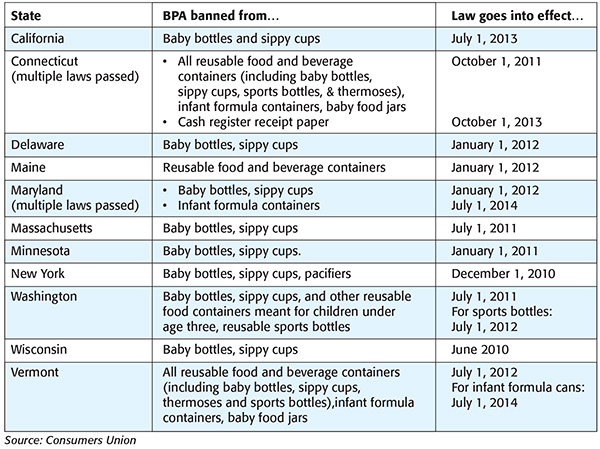Bisphenol A (BPA) is a synthetic estrogen and industrial compound often used in polycarbonate plastics to assist with hardening. It’s commonly found in the coatings of food and drink containers, baby bottles, sippy cups, food storage wrap and food packaging. It can enter the human body by way of eating, drinking, inhalation and skin absorption.
The arguments surrounding the use of and exposure to BPA is not new. A few years ago, the U.S. Food and Drug Administration (FDA) banned BPA in baby bottles and sippy cups. And just last year, the agency confirmed that exposure levels--measured as Tolerable Daily Intake (TDI)--of 5 micrograms per day is safe--a finding based on 300 scientific studies over a 5-year span.
This brings about a puzzling question--if BPA is not safe for baby products, how is it still safe for everyone else?
The Case for BPA
It cannot be denied that--despite the arguments against BPA use--the compound does serve a very important purpose to the food industry and consumers. Simply put, the epoxy resin that lines metal cans helps to prevent corrosion and other contaminants that can lead to food safety concerns, including botulism. Without this coating, food could become contaminated by metal or microbes, not to mention that cans would eventually erode and leak. To that end, proponents strongly believe that the presence and inclusion of BPA in food packaging is necessary to ensure that food items retain their nutrition, quality and safety. Perhaps the most important part of the argument for BPA is no one has proven that it specifically or exclusively causes any illness or disease in humans.
The Case Against BPA
The apparent effects of BPA, though, are hard to swallow. With consumers demanding more transparency in terms of food safety, much attention has been placed on the synthetic compound and how it can negatively affect the human body--specifically fetal development, brain development and future behavior.
Last December, one study carried out by the Institute of Environmental Medicine College at Seoul National University examined the effects of drinking soy milk from a can. Participants that did so not only exhibited dramatic increases in BPA present in their urine, it also appeared to spike their blood pressure levels--all within just 2 hours of consumption. When the participants drank soy milk from glass bottles--which do not use BPA linings--their BPA levels and blood pressure showed no significant changes. This is the first study that shows a single exposure to BPA can have a direct, immediate impact on cardiovascular health.[1]
Researchers at Rowan University School of Medicine and Rutgers New Jersey Medical School confirmed unprecedented findings earlier this year when their study linked BPA and autism in children. The research--which involved 46 children with autism and 52 without it--proved that BPA is processed differently in both sets of children. Simply put, children with autism have a more difficult time metabolizing BPA. This study in particular is groundbreaking because previous research only involved animals, not human participants.[2]
Yet another study--this one by Canada’s University of Calgary--focused on the effects of very low doses of BPA and bisphenol S (BPS)--a BPA alternative--on zebrafish embryos. The result? Altered brain development and eventual signs of hyperactivity--both of which increased by 180 percent and 240 percent, respectively.[3]
On the other hand, some research appears to support what BPA proponents have been saying all along.
In April, a study conducted by the Johns Hopkins Bloomberg School of Public Health was published in The Journal of Pediatrics. According to researchers, BPA risk to newborns may be smaller than what’s been previously declared. Existing research--specifically published by the U.S. Centers for Disease Control and Prevention--focuses on BPA exposure in Americans aged 6 years and older. No study had ever been conducted on healthy newborns since it was assumed that their underdeveloped lives would not easily process BPA, leading to increased health risks. Over an 8-month period between 2012 and 2013, researchers collected urine samples from full-term, newborn babies between 3 and 27 days old. The researchers found no “free” BPA--the chemical as it appears in consumer products--in the urine samples, but 70 percent of the samples did contain BPA glucuronide--a substance that is “biologically inert and therefore considered harmless to the body.”[4]
And the studies don’t end there.
The California Office of Environmental Health Hazard Assessments says that BPA exposure may also impact reproductive organs in pregnant women.[5]
The National Conference of State Legislatures and Proceedings of the National Academy of Sciences says that research links BPA exposure to a laundry list of diseases and ailments--cancer, heart disease, diabetes, obesity and some childhood neurological disorders.[6, 7]
U.S. Regulations
Regulation of BPA use falls under the jurisdiction of the FDA. Even the agency has been known to cast doubt on the synthetic compound, hinting that exposure can have negative effects on “the brain, behavior and prostate gland of fetuses, infants and children.” Thus, in 2012, the FDA decided to ban the use of BPA in baby bottles and sippy cups. The ban did not apply to other consumer products. (National Conference of State Legislatures) Individual states have followed suit, implementing and enforcing their own mandates to regulate or completely ban BPA use in products.[8]
The FDA’s current perspective is that “BPA is safe at the current levels occurring in foods.” Their opinion is based on the agency’s most recent safety assessment conducted in 2008 and updated in 2009.[9] Despite what this federal agency has to say, some parts of the U.S. are not ready to give up just yet.
For example, the “Toxic Free Kids Act” in North Carolina maintains that BPA should be banned because parents cannot easily decipher toxic products from safe ones.[10]
After multiple attempts dating as far back as 2009, California’s Office of Environmental Health Hazard Assessment’s scientific panel--the Developmental and Reproductive Toxicant Identification Committee--finally voted unanimously in May 2015 to add BPA to the state’s own Proposition 65--a list of chemicals known to cause cancer or reproductive toxicity. California specifically says that BPA causes “reproductive toxicity based on a report by the National Toxicology Program’s Center for the Evaluation of Risks to Human Reproduction.” The report was based on laboratory tests conducted on animals. Factors that BPA impacted included litter size, body weight, birth rate and puberty.[11]
 So far, at least 11 states have enforced their own laws banning BPA in certain products--primarily baby bottles and sippy cups. Many of these regulations were proposed and instituted before the FDA’s own ban.
So far, at least 11 states have enforced their own laws banning BPA in certain products--primarily baby bottles and sippy cups. Many of these regulations were proposed and instituted before the FDA’s own ban.
BPA Regulations Worldwide
In January, the European Food Safety Authority’s (EFSA) Panel on Food Contact Materials, Enzymes, Flavorings and Processing Aids issued a final report stating that BPA poses no health risk to consumers of any age group--including unborn children, infants and adolescents. With the help of various national authorities and stakeholders for the most transparent outcome possible, the EFSA’s risk assessment and evaluation included not only BPA in food, but also from a number of other potential sources of exposure. The health risk in both food and nonfood items is nonexistent because “current exposure to the chemical is too low to cause harm.” However, the EFSA has said that consumers should still use caution since high doses of BPA can have negative effects on the kidney and liver.[12, 13]
Not all parts of Europe are comfortable with use of and exposure to BPA. As of January 1, 2015, France banned the use of BPA “for products intended to come into direct contact with food”. The enforcement of this law resisted the EU’s stance on BPA, and Member States have publicly expressed their disappointed with France’s audacity to implement their own laws in regards to BPA.[14]
Earlier this year, the EcoWaste Coalition in the Philippines asked the country’s Department of Health to formally ban the manufacturing, importation, advertisement and sale of baby bottles and sippy cups containing BPA. Their reason? They claim that the synthetic compound has been linked to cases of asthma, autism, infertility and even various types of cancer but offer no citations to back these claims. The group also says there’s a number of scientific studies, again uncited, that validate their concern for public health. Critics believe that part of the reason the Philippines has not opted to ban BPA in plastic bottles and sippy cups is because the country lacks the technology and capacity to carry out such testing.[15]
Industry Views
In January, the American Chemistry Council released a statement endorsing the EFSA’s findings that BPA poses no risk as exposure levels are too low to cause any harm.[16]
[The EFSA’s final report] “provides still more substantiation that the current uses of BPA in food packaging are safe. Given that Europe is the birthplace of the Precautionary Principle, this announcement takes on even more prominence, as Europe’s leading food safety body reassures consumers that BPA exposure from foods is not a health concern,” states John Rost, chair, North American Metal Packaging Alliance, Inc.[17]
The plastics industry is concerned that with increased regulations and bans of BPA, both manufacturers and consumers will avoid buying plastic products without fully understanding that their exposure is typically minimal and therefore inconsequential.[18]
Some companies are even making moves to separate themselves from the perceived harms of BPA.
Trader Joe’s and a host of other brands claim not to use BPA at all. On July 30, 2015, ConAgra Foods announced that they had completed the transition to cans without BPA liners for products made in its U.S. and Canadian facilities--an effort that began in 2010. “Our ongoing commitment to consumers means that we constantly work to improve our packaging to assure quality and the overall experience,” says Gail Tavill, vice president, Packaging & Sustainable Productivity, ConAgra Foods. “We recognize consumer interest in removing BPA from our cans and are pleased to be able to respond to that desire and offer food that our consumers can feel confident in.”
The company is now working with international suppliers who still import products with BPA-lined cans, but they expect a complete transition by early 2016.[19]
Alternatives to BPA
Although it is considered a success that BPA use in products and packaging is slowly falling by the wayside, there is growing concern regarding what chemicals and materials will replace it--namely BPS and bisphenol F. Jane Muncke--managing director at the Food Packaging Forum Foundation--says that there is cause for concern if replacement materials aren’t being tested for safety. “For example, some coatings are now made with BPS that is toxicologically similar to BPA though it likely migrates less,” she says.[20] Critics believe that simply transitioning to other materials that have properties similar to those of BPA actually isn’t a step in the right direction.
Furthermore, a statement by the Grocery Manufacturers Association (GMA) goes into great detail regarding why an alternative to BPA would be far too chaotic for the industry:
“The process to find a replacement for BPA that will work in all applications will take time. This is because both the safety and quality of the food as well as the performance of the alternative must be confirmed over the entire shelf life of every food product – container combination. Also, the time it would take for companies to actually make the transition to a suitable alternative could be very lengthy given the potential changes can manufacturers and food processors would have to make in their equipment and operations.”[21]
GMA believes that a ban on BPA would immediately impact packaged and canned food items that we consume everyday--from baby food and condiments to beverages and meats.
What Happens Next?
Although the EFSA’s findings are conclusive, it is expected that they will continue to evaluate what are safe levels of BPA by incorporating outcomes from ongoing research by the U.S. National Toxicology Program and the FDA.
On the consumer front, there is still a dilemma--how does one know if the products they’re buying contain BPA? Although a number of companies have publicly abandoned BPA, many more have not.
In 2014, the Environmental Working Group (EWG) spent 8 months analyzing 252 canned food brands to find out which ones contained BPA coatings. They found that 78 brands used cans with BPA-based epoxy lining for all of their products, including Ocean Spray, Hormel, Goya, Progresso, Del Monte and Chef Boyardee. There were 31 brands that used BPA-free cans for all of their canned products, including Tyson and Sprouts Farmers Market. EWG’s study--“BPA in Canned Food: Behind the Brand Curtain”--was published in May 2015 and contains a complete summary of their analysis and results by brand.[22]
On a general level, there are things that consumers can do to limit their exposure to BPA, according to the National Institutes of Health:
- Reduce consumption and use of canned foods.
- Check plastic containers marked with cycle codes 3 or 7--they are most likely to contain BPA.
- Avoid microwaving plastic food containers since high temperatures can break down polycarbonates.
- Opt for glass, porcelain or stainless steel containers instead of plastic ones.
- Check food labels--some do show if they are made with neither BPA nor BPS.
With such a wide array of resources and opinions on the subject, the question of whether or not BPA is truly safe remains in the eye of the beholder.
References
1. http://medicalresearch.com/author-interviews/bpa-canned-soda-linked-increased-blood-pressure/9525/?.
2. http://njms.rutgers.edu/archives/.
3. http://www.pnas.org/content/112/5/1475.full.pdf.
4. http://www.jhsph.edu/news/news-releases/2015/bpa-risk-to-newborns-may-be-smaller-than-previously-believed.html.
5. http://www.oehha.ca.gov/prop65/CRNR_notices/list_changes/pdf/BPAfacts041113.pdf.
6. http://www.ncsl.org/research/environment-and-natural-resources/policy-update-on-state-restrictions-on-bisphenol-a.aspx.
7. http://www.pnas.org/content/112/5/1475.full.pdf.
8. http://www.ncsl.org/research/environment-and-natural-resources/policy-update-on-state-restrictions-on-bisphenol-a.aspx.
9. http://www.fda.gov/downloads/NewsEvents/PublicHealthFocus/UCM424266.pdf.
10. http://www.ncleg.net/gascripts/BillLookUp/BillLookUp.pl?Session=2015&BillID=S81.
11. http://www.oehha.ca.gov/prop65/CRNR_notices/list_changes/pdf/BPAfacts041113.pdf.
12. http://www.efsa.europa.eu/en/press/news/150121.htm.
13. http://www.food-safety.com/news/efsa-low-exposure-to-bpa-triggers-no-consumer-health-risk/?
14. http://www.bisphenol-a-europe.org/uploads/Modules/Mediaroom/stm_re_french-bpa-ban-being-enforced-01-01-2015.pdf?.
15. http://ecowastecoalition.blogspot.com/2015/01/ecowaste-coalition-pushes-doh-to-ban.html.
16. http://www.americanchemistry.com/Media/PressReleasesTranscripts/ACC-news-releases/European-Food-Safety-Authority-Scientific-Experts-Strongly-Support-Safety-of-BPA.html.
17. http://www.metal-pack.org/docs/pdf/00151331.PDF.
18. http://www.plasticsnews.com/article/20150507/NEWS/150509939/california-panel-deliberates-adding-bpa-to-prop-65-list.
19. http://www.conagrafoods.com/news-room/news-ConAgra-Foods-Removes-BPA-from-Cans-across-Portfolio-2072842.
20. http://www.foodproductiondaily.com/Packaging/ConAgra-Foods-removes-BPA-from-all-its-US-and-Canada-cans.
21. http://www.gmaonline.org/downloads/wygwam/NR_BPA_SO.pdf.
22. http://static.ewg.org/reports/2015/bpa_in_canned_food/BPA-in-canned-food.pdf?_ga=1.151355321.1852115211.1440085498.




